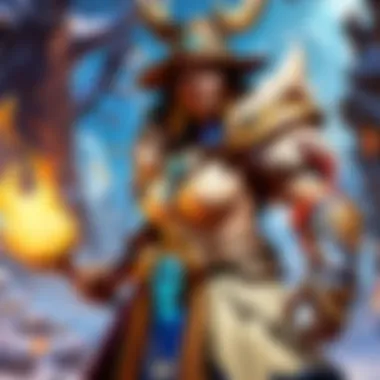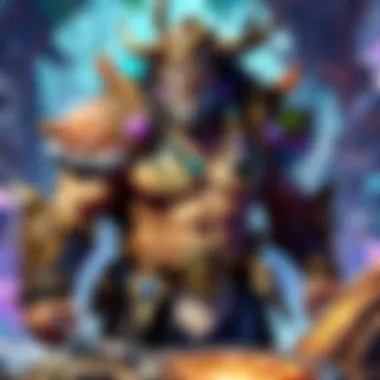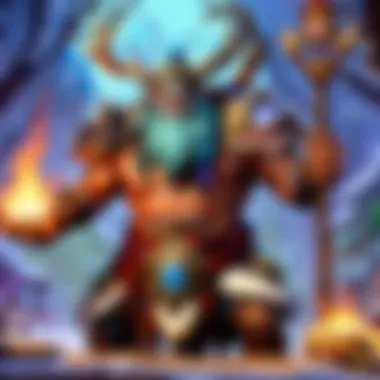Mastering Shaman Spells in Hearthstone: Strategies and Insights


Intro
Hearthstone, a card game developed by Blizzard Entertainment, offers diverse and complex gameplay mechanics that challenge players of varying skill levels. Among the hero classes, the Shaman stands out due to its unique spells, blending strategy and versatility. This article analyzes Shaman spells, delving into their mechanics, evolution, and strategies for competitive play. Understanding these spells is crucial for effectively engaging in Hearthstone's rich gameplay environment.
Game Updates and Patches
Overview of the latest game updates and patches from Hearthstone
Hearthstone consists of evolving gameplay requiring players to stay updated with its patches. Regular updates introduce balance changes, buffs, and nerfs, affecting how Shaman spells perform in various scenarios. Keeping abreast of each patch is essential for evaluating which spells are most advantageous.
Detailed breakdown of changes and its impact on gameplay
In the latest update, Blizzard modified several core Shaman spells, tweaking their costs, effectiveness, or mana generation. For instance, changes to spells like Lightning Bolt or Hex can lead to significant shifts in deck strategies and overall gameplay dynamics. Players need to thoroughly assess how these changes can reinforce or obstruct their game plans.
Analysis of new cards and mechanics introduced
New expansions often unveil fresh cards that expand the Shaman's spell repertoire. Examining these cards offers insight into potential synergies and strengths. Effective integration of new mechanics adds layers to gameplay, keeping strategies dynamic and allowing players to adapt their approaches regularly.
Deck Strategies and Meta Analysis
Top deck recommendations for different play styles and skill levels
Choosing the ideal deck for Shaman depends on personal play style. Whether favoring aggressive, control, or combo tactics, various decks utilize Shaman spells effectively. Some noted recommendations for different levels include:
- Aggro Shaman: Emphasizes speed and overwhelming opponents quickly.
- Control Shaman: Focuses on board control and longevity, usign powerful spells to outlast opponents.
- Midrange Shaman: A blend of offense and defense, yielding flexibility in strategies.
Insight into the current meta and popular deck archetypes
Adhering to trends in the meta can ensure players are equipped with optimal decks. Observing community discussions facilitates a deeper understanding of what strategies prevail. High-win-rate archetypes often include Zalon, Postalfish, or Evolve Shaman. Recognizing these patterns guides informed deck-building decisions.
Strategies for countering popular decks and tech choices
Moreover, being prepared to combat popular decks is vital. Key counter strategies involve:
- Utilizing spells with disruptive properties, such as Lightning Storm.
- Adapting to enemy spells and employing tech cards support your strategy.
Card Reviews and Set Reviews
In-depth reviews of new cards and their potential impact on the meta
Each new card release brings potential shifts in the game. Observing how cards function individually and as components of Shaman decks informs overall strategy. Understanding nuances of New spells helps to maximize effectiveness during play.
Evaluations of card synergies within different deck archetypes
Assessment of synergistic combinations leads to innovative tactical builds. For example, Serpent Shrine Portal synergizes well with Aggro strategies while offering versatile board control options.
Set reviews focusing on value, versatility, and competitive viability
New expansions must be scrutinized not just for their additions but overall balance. Certain cards, such as Murozond the Infinite, bolster various sets and can reshape meta strategies. Recognizing competitive viability fosters adaptability.
Player Guides and Tips
Beginner's guides to understanding core game mechanics and strategies
For novice players, comprehending key game mechanics pays dividends. Resources should highlight how to utilize a Shaman's card advantage through spells and summons, addressing mana management and tempo.
Advanced tips for improving gameplay and decision-making
Savvy players often look for nuanced prompts that minimize error. Higher-level strategies include anticipating opponent moves and adapting rewired decks in advance to counter challengers more effectively.
Arena drafting strategies and arena-specific gameplay tips
Exploring the arena allows for well-rounded skill development. Topics like optimal pick sequences for Shaman cards and recognizing contextual value based on ongoing pickups should be apparent in drafting strategy discussions.
Engaging with these elements will position players for better outcomes within Hearthstone and a firmer grasp of Shaman spells through ongoing concepts. Enriching one’s comprehension leads to more impactful gameplay.
Preface to Shaman Spells
Shaman spells in Hearthstone represent an intriguing blend of mysticism and elemental power. Understanding this aspect enriches the gameplay experience. Players can appreciate the dynamics and strategies inherent to this class by delving into shaman spells' mechanics and their significance on the battlefield. Being knowledgeable about these spells allows players to tailor their approach and adapt to various situations during matches. Effective use of spells contributes to diverse strategies in both competitive and casual play. Additionally, a solid comprehension of current spell offerings provides insights into deck building. This depth adds a layer of engagement to the gaming session, whether as a player looking to improve or as a casual observer learning about shamanic tactics.
Historical Context of Shaman Spells
The evolution of shaman spells in Hearthstone is significant. Initially introduced with the game, shamans had spells aimed primarily at summoning totems and dealing damage directly. Over the years, expansions have introduced various mechanics and use cases. Noteworthy spells such as "Lightning Bolt" catered to direct damage while fostering early aggression strategies. During formative expansions like "The Grand Tournament", new mechanics such as Overload emerged, expanding the tactical possibilities for shaman players.
In the developmental narrative, spells also integrated thematic elements relevant to shaman lore from World of Warcraft. This cultural connection allowed players to recognize familiar artifacts and tactics incorporated in shaman gameplay. Knowing the historical context aids players in recognizing meta shifts and different ways shaman's iron spell repertoire manifests.
Current Spell Set Overview


At present, shaman spells encompass a diverse range of functionalities, separating themselves into distinct categories. The spell set typically includes direct damage spells, utility spells for healing, and methods for summoning totems. Here are some essential components of the current spell arsenal:
- Damage spells: These focus on dealing direct harm, with renowned cards such as Lightning Bolt and Fire Elemental. Such spells allow quick removal of threats or enable aggressive strategies.
- Healing and restoration spells: Cards like Healing Rain provide a regeneration mechanism, assisting in outlasting enemies which characterizes late-game tactics.
- Totemic spells: Totem Golem and Argent Watchman enhance board control and support strategic setups.
- Chaotic and random effects: Cards like Sirocco shake up familiar spells, incorporating unpredictability.
The versatility of shaman spells establishes nuanced tactics, catering to various deck archetypes and evolving combat scenarios in Hearthstone.
In essence, the salient features of the current spell set illustrate shaman spells' continuous adaptation within the Hearthstone landscape, offering countless potentials and varied strategies for players.
Categories of Shaman Spells
The categories of Shaman spells play a crucial role in understanding the strategic depth of this class in Hearthstone. By recognizing the different types of spells available, players can adapt their techniques and enhance their gameplay. Shaman spells can be broadly categorized into four distinct groups, each with unique characteristics and applications. This classification not only helps in deck building but also enables a more efficient use of spells during gameplay. Here, we explore these categories thoroughly, detailing their implications in terms of strategy and game mechanics.
Damage Dealing Spells
Damage dealing spells are fundamental in Shaman decks, serving to remove opposing threats or push for decisive victories. These spells are often direct, meaning they can target enemy creatures or the hero directly, delivering reliable damage. Notable examples include Lightning Bolt and Lava Burst, which provide substantial immediate impacts.
The advantage of these spells is their ability to influence board state actively. A well-timed Fire Elemental can clear sizeable threats, while Stormstrike offers flexibility by combining damage with potential weapon enhancements. Their efficiency is further multiplied when combined with spell synergist effects, enabling players to create strong, damage-oriented combos.
Healing and Restoration Spells
Healing spells serve an equally important role in Shaman strategy. They offer a means to regain health, allowing players to withstand aggressive onslaughts. Cards like Healing Rain and Earth Shield protect life points and sustain longevity in games, particularly in aggressive matchups.
Healing effects often come with unique mechanics. For instance, Bloodlust not only restores health but also enhances the offensive power of minions. This demonstrates the versatility found within healing spells, indicating their potential dual role in both defensive and aggressive plays. Balancing these healing qualities against damage dealing brings complexity to Shaman gameplay.
Totemic Spells
Totemic spells possess unique mechanics that can alter the battlefield significantly. They produce totems, each offering varied benefits. For example, Totemic Call allows players to summon one of four totems with distinct abilities, accordingly providing multiple strategic advantages.
Totems can be game-changers. The Mana Tide Totem provides card draw, while the Healing Totem restores health each turn. This variability allows players not only to adapt to immediate game states but also to implement longer-term strategies. Totemic spells offer significant value, where their selection and timing can tactically shift game flow toward the shaman player.
Chaotic and Random Effects
Lastly, chaotic and random effects constitute a distinct subgroup of spells that reflect the Shaman’s unpredictable nature. This category includes spells like Stormchaser, which can yield unexpected, high-impact results. Cards found in this category often pivot gameplay by introducing elements of surprise that can build pressure on opponents.
The randomness of such spells can lead to dramatic swings in advantage. For example, if played successfully, Spellslinger can generate additional benefits, offering access to various spells on the abrupt. While this randomness poses its risks, the potential payoffs make it an exhilarating component in Shaman decks, encouraging risk-aware decisions during games.
The strategic understanding of different spell categories in Hearthstone's Shaman offers players important insights. Each category brings its unique utilities, enriching gameplay and strategy decision-making.
Each of these spell categories helps define the integral role of the Shaman in competitive settings. By utilizing the full diversity offered by damage dealing, healing, totemics, and chaotic spells, players can create formidable strategies that not only leverage strengths but also counteract opponents effectively.
Mechanics Behind Shaman Spells
The mechanics behind Shaman spells in Hearthstone play a crucial role in distinguishing this class from others. Understanding these mechanics allows players to strategically exploit the unique strengths of the Shaman, using spells not only for direct impacts but also to create synergies that enhance overall gameplay.
Spell Synergy with Totems
Shaman spells often have a direct connection with totem mechanics. Totems are essential in navigating Shaman strategy effectively. They operate to supplement the shaman's capabilities, providing support in offense or defense. For instance, totems like Stoneclaw Totem can absorb damage from opponents, while Healing Stream Totem can sustain the health of minions and the player.
Making full use of totems allows players to trigger several spell effects. Some spells can gain bonuses or be discounted entirely when certain totems are on the board. For instance, the spell Spirit of the Frog allows Shaman spells to draw extra cards when played, further promoting a cycle of spells and effects. Keeping control of totems enables a strategic advantage that several other classes can’t match easily.
The Role of Overload
Overload is a unique mechanic associated specifically with many Shaman spells, encouraging just in time reinforcement at the cost of your future mana. It introduces a layer of decision-making in gameplay. When players use spells with overload, they must be careful planning their future turns after the spell is cast. For example, Lightning Bolt is a powerful card, but utilizing it can temporarily restrict your mana pool.


This trait fosters a balance; players are drawn to explosive plays but must weigh the aftermath. Overload rewards those who can anticipate opponent moves while planning their own future card plays. The ability to build tempo or stall an opponent’s actions is essential. It captures both strength and necessary caution when navigating possible board actions.
Discovering Mechanics
Analyzing Shaman mechanics sheds light on broader gameplay strategies within Hearthstone. Each card usually brings particular interactions that can lead to creative plays. Cards like Frigidara synthesis various card combinations to generate decisions and outcomes.
Strategic Usage of Shaman Spells
Strategic usage of Shaman spells plays a pivotal role in gameplay. Understanding when and how to deploy these spells can be the difference between victory and defeat. Each game unfolds uniquely, requiring players to adapt their strategy in response to their opponent's actions and current board state. This adaptability is largely proficient when players familiarize themselves with the specific strengths of their Shaman spells, optimizing their effects for maximum benefit.
Early Game Strategies
In the initial phases of the match, getting a strong foothold is important. Utilizing Shaman spells efficiently can help establish board presence or pressure the opponent. You might consider spells like Lightning Bolt or Plague of Murlocs, allowing for targeted damage or potential enemy distraction. Key tactics here include:
- Establishing Control: Use spells that provide immediate board impact. This sets up a foundation upon which you can build your strategy.
- Resource Management: Draw out enemy spells by provoking reactions and using resources efficiently. Property managing resources is crucial in maintaining momentum.
- Pressure Your Opponent: Aim to deliver damage early, which encourages your opponent to obfuscate their own strategy—perhaps leading to misplays.
Adopting these strategies at the early stage can greatly fortify your timing and decision-making for the later win conditions.
Mid-Game Adaptations
As the game advances, your strategies must evolve in response to board dynamics and shifting resources. During this phase, bloodlust emerges not only as a powerful offensive tool but a way to surprise your opponent with sudden power. Significant considerations that come into play include:
- Understanding the Enemy's Threats: Adapting means accurately understanding what spells or minions may come next. Anticipating your opponent's next move will allow counterplays as needed.
- Combining Spells Wisely: Look for synergies between spells and minions. Techniques such as totem summoning followed by supporting spells can amplify your overall power exerted on the board.
- Reducing Overwhelm: The mid-game is crucial when enemies intensify board control; effective use of shields through Shaman spells might delay impending doom.
Effectively employing adaptability during this stage leads to gradual but undeniable boosts in your positioning.
Late Game Considerations
In the later stages of the game, conserving resources while judiciously applying power turns into an art. Understanding which Shaman spells fit into this critical moment becomes essential. Effective late-game strategies may include elements such as:**
- Finishing Moves: Spells like Spirit of the Frog provide excellent draw usability while preparing for strong finishers through pressure.
- Maximizing Damage: Spamming spells with damage and utility would often discourage opponent engagements on-board effectively. Choosing the right timing for each play is paramount.
- Threat Management: At the conclusion of a match, identify existential threats precisely and dictate careful 'spell-allas' maneuvers to smother enernsenshi.
Through complementary use of one or more abilities, the late game position may show opposing players their fate, transcending when managed well. Inclusion of spell knowledge synthesized with gameplay enhances winning complexity and can lead human operators toward honorable outcomes.
Mastery of strategic usage is not merely about the spells themselves, but the synergy and timing which players cultivate during all stages of play.
Shaman Spell Interactions with Other Classes
Understanding how Shaman spells interact with other classes is a fundamental aspect of gameplay strategy in Hearthstone. Inter-class dynamics play a pivotal role in constructing decks and formulating win conditions. Players must recognize the strengths and weaknesses of Shaman spells, to build resilient strategies and effectively counter opponents. Skills crucial to navigating these interactions lead to enhanced gameplay experiences.
Counterplay Mechanics
Shaman spells often have specific counterplay mechanics that can be exploited by aware opponents. There are spells with powerful effects like Hex or Fire Elemental that can quickly shift the balance of the game. In contrast, classes such as Warlock benefit from cards like Twilight Drake or Doomguard that can leverage Shaman weaknesses.
Effective counterplay requires understanding both your built deck and your opponent’s. Anticipating a potential Lightning Storm can lead to switching strategies that puts a damper on Shaman’s aggressive game plan. While Shaman excels at controlling the board, decks that focus on burst damage or disruptive spells may leave them vulnerable.
Complementary Class Interactions
Shaman spells can synergize well with other class cards leading to advantageous plays, creating a complementary effect when combined with certain classes.
Notably, the Druid can use health-restoring spells to counterbalance the excess damage dealt by Shaman spells. Cards like Healing Touch alongside Shaman's damage dealers can forge strong sustain capable scenarios. ىن this synergy may propel overall board control.
Classes such as Mage, with a focus on direct damage, can produce a chain of effects often dangerous for the Shaman if timing is not executed comprehensively. Combined efforts of Frostbolt and Fireball could suppress Shaman spells outright, creating an uphill battle.


Community Insights and Meta Analysis
Understanding community insights and conducting meta-analysis play critical roles in grasping how shaman spells fit within the larger ecological fabric of Hearthstone. These topics invite players to consider not just their cards and strategies, but also the evolving trends and responses of the player base. Such insights lead to a richer understanding of meta dynamics, ultimately influencing player decision-making and deck building.
Current Meta Trends
Current meta trends reflect the broader shifts in gameplay preferences and strategic innovation. As new expansions release or patches alter existing card mechanics, players respond by adapting their play styles and card choices. For shaman spells, recognizing these trends helps in two main ways:
- Ranking of Effectiveness: It allows players to determine which spells and decks are performing well and are favored in the competing landscape. This awareness aids in forming strategies that could enhance winning potential.
- Counter-Trends: Players can identify which cards or archetypes are struggling and adjust their plans accordingly.
For instance, if control shaman decks like those using Bloodlust gain traction, aggressive counters may emerge, flipping the meta dynamics. Monitoring reliability of spells in diverse match-ups becomes essential. Social media platforms, forums like Reddit, and data analytics tools have become instrumental for gathering observations and understanding shifts.
Popular Deck Archetypes
The variety of deck archetypes highlights the versatility of shaman spells. These decks are shaped by a combination of community feedback and ongoing development adjustments made by the Hearthstone team. Key archetypes include:
- Aggro Shaman: Fast-paced decks focusing on quickly overwhelming the opponent with low-cost minions and spells.
- Control Shaman: Slower decks that emphasize Healing Rain and board control to outlast opponents.
- Combo Shaman: This archetype leverages specific spells and combinations to deal massive damage in a single turn.
- Midrange Shaman: Balances early game pressure with stronger minions and versatile spells to adapt to opposing strategies.
The discussions in Facebook groups or on Reddit fuels innovations at the grassroots level. Players post new discoveries or modifications based on their experiences. Tuning into these conversations can provoke inventive building bolstered by community input.
Future of Shaman Spells in Hearthstone
The future of Shaman spells is a topic that invokes curiosity and anxiety among players and enthusiasts of Hearthstone. As card balancing and mechanics evolve, understanding future directions helps players anticipate shifts in gameplay and adapt their strategies accordingly. Balancing changes play a crucial role in keeping the game dynamic, while predictions regarding new expansions offer insight into potential spells that could enrich the Shaman class.
Balancing Changes
As Hearthstone continues to grow, the developers actively engage in balancing changes to maintain competitiveness. For Shaman spells, this often includes adjusting the power level of certain cards, which can impact not only how effective individual spells are but also the collective strength of Shaman decks.
These changes are crucial because they prevent overarching dominance from a single class or strategy, encouraging diversity in the meta. Players should note that balancing adjustments happen frequently, which means they need to remain aware of updates to spell functionalities, costs, and effects. Some spells may be nerfed to limit their impact, such as reducing damage outputs or increasing mana costs, while others may receive buffs to encourage new strategies from players.
Consider the impact of spells like Fire Elemental, which can see a reduction in mana costs for faster plays or an increase in its attack for additional damage.
Predictions for New Expansions
New expansions are an exciting aspect of Hearthstone, often revealing fresh mechanics and spell varieties for classes. Predictions around new expansions for Shaman spells include themes revolving around elemental interactions, leveraging powerful totems, or reworking Overload mechanics for innovative strategies. Expect the introduction of spells that synergize with existing mechanics while pushing for new playing paradigms.
Rumors and hints usually circulate in the Hearthstone community ahead of release announcements. One can consider that upcoming sets might incorporate legendary spells tailored for the Shaman class or enhance their current unique abilities. A July 2023 prediction hinted at spells emphasizing wind and air elements—bringing spells like Windfury into strategic discussion.
Impactful changes may also include spell interactions that allow players to draw from a larger pool of collectible spells across deck types, further enriching gameplay diversity.
In summary, balancing changes and predictions surrounding new expansions profoundly shape the trajectory of Shaman spells, ultimately demanding players to be vigilant and proactive in adjusting their strategies.
Epilogue
Shaman spells in Hearthstone hold significance beyond simple gameplay mechanics; they embody the unique identity and a strategic depth of this class. Their dynamic nature allows for ever-evolving strategies, prompting players to adapt continuously. This concluding section reinforces the relevancy of understanding the various elements of shaman spells and offers critical insights for enhancing player experience and success in matches.
Summary of Key Points
In summary, the extensive examination of shaman spells reveals several key aspects that warrant attention:
- Diverse Mechanics: The versatility in spell types, including damage dealing, healing, and totemic conjurations, provides a comprehensive arsenal capable of addressing various in-game scenarios.
- Strategic Applications: Effective use of these spells can shift games substantially by controlling tempo, managing resources, or adjusting to opponents’ strategies, highlighting crucial adaptations throughout different phases of play.
- Meta Relevance: Shaman spells keep the gameplay vibrant, often altering the competitive landscape. Their role will likely continue to expand with each expansion, posing both opportunities and challenges.
- Player Investment: Understanding the workings of each spell contributes directly toward better deck building and refinement, which in turn can substantively increase win rates.
Final Thoughts on Shaman Spells
Reflecting on shaman spells, it is evident that they are a blend of complexity and straightforwardness, making them appealing for both novice players looking to grasp fundamental mechanics and advanced players searching for intricate strategies. The balance between spells' individuality and their compound effects offers ample room for creativity in constructing decks. As Hearthstone progresses, the evolution of shaman spells will inevitably provoke debates among strategists about optimization and inspiration.
The landscape of competitive spell usage in Hearthstone hinges on both individual creativity and an understanding of overarching strategic trends. Contributions from the community continually shape the future of shaman strategies, ensuring that this class remains intriguing and challenging.
Engagement with the ongoing discourse within player communities, whether on platforms like Reddit or through other channels, also adds depth to our understanding, keeping us attuned to emerging trends and novel ideas.
In essence, enthusiasm and insight into shaman spells translate not only into higher levels of play but also deeper enjoyment of the strategic richness that Hearthstone offers.







